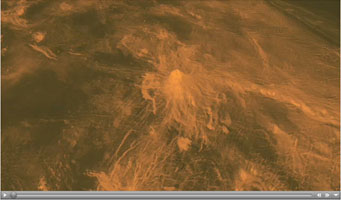Surface Warmth on a Venus Volcano
 |  |
| Figure 1 Colored Overlay | Animations Annotated No Annotation |
This figure shows the volcanic peak Idunn Mons (at 46 degrees south latitude, 214.5 degrees east longitude) in the Imdr Regio area of Venus. The topographic backbone derives from data obtained by NASA's Magellan spacecraft, with a vertical exaggeration of 30 times. Radar data (in brown) from Magellan has been draped on top of the topographic data. Bright areas are rough or have steep slopes. Dark areas are smooth.
The colored overlay in Figure 1 shows the heat patterns derived from surface brightness data collected by the Visible and Infrared Thermal Imaging Spectrometer (VIRTIS), aboard the European Space Agency's Venus Express spacecraft. Temperature variations due to topography were removed. The brightness signals the composition of the minerals that were changed due to lava flow. Red-orange is the warmest area and purple is the coolest. The warmest area is centered on the summit, which stands about 2.5 kilometers (1.6 miles) above the plains, and the bright flows that originate there. Idunn Mons has a diameter of about 200 kilometers (120 miles).
The spectrometer data was collected from May 2006 to the end of 2007. A movie featuring 360-degree views of the volcano is based on the same data and can be viewed at JPL's Multimedia.
Venus Express was built and is managed by the European Space Agency. The spacecraft's visible and infrared thermal imaging spectrometer was built and is led by INAF-IASF (Istituto di Astrofisica Spaziale e Fisica Cosmica), Rome, Italy, and LESIA (Laboratoire d'tudes spatiales et d'instrumentation en astrophysique), Observatoire de Paris, France, with support from their national space agencies.
More information on the Venus Express mission is available at http://www.esa.int/SPECIALS/Venus_Express/index.html.
